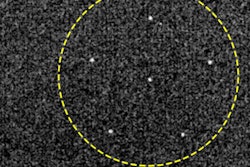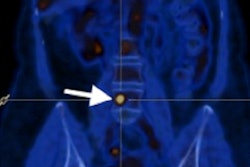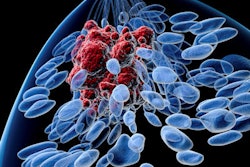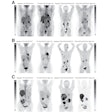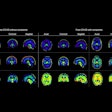
A new scanning technique that uses hyperpolarized carbon-13 MRI to monitor the metabolism of different types of breast cancer can identify how rapidly a tumor is growing. The technique, developed by researchers at Cancer Research UK Cambridge Institute and the University of Cambridge, could help doctors prescribe the best course of treatment for patients and follow how they respond.
Breast cancer accounts for roughly a quarter of all cancer cases worldwide and is the leading cause of cancer death in women. There are many subtypes of breast cancer, with some being more aggressive than others. The new technique is the first to be able to detect differences in a tumor's size, type, and grade (a measure of how fast it is growing), while also yielding information on the variations in metabolism between different regions within the tumor.
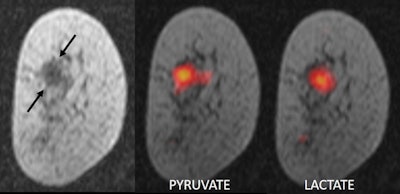 MR imaging of a breast tumor. Left panel: anatomic image of a breast cancer (arrows); middle panel: pyruvate in the tumor; right panel: lactate in the tumor. All images courtesy of Dr. Ramona Woitek, PhD.
MR imaging of a breast tumor. Left panel: anatomic image of a breast cancer (arrows); middle panel: pyruvate in the tumor; right panel: lactate in the tumor. All images courtesy of Dr. Ramona Woitek, PhD.Measuring pyruvate metabolism
The technique works by measuring how fast a tumor metabolizes a naturally occurring sugar-like molecule called pyruvate. In their experiments, the researchers used pyruvate that they had labeled with carbon-13, a heavier isotope of carbon. They then hyperpolarized, or magnetized, this carbon-13 pyruvate by cooling it to -272° C and exposing it to an extremely strong magnetic field and microwave radiation in a special machine called SPINlab. The frozen pyruvate sample was then thawed, dissolved into a solution, and injected into the patient, who immediately underwent an MRI scan (Proceedings of the National Academy of Sciences, 28 January 2020, Vol. 117:4, pp. 2092-2098).
Tumors make use of large amounts of sugar and take up more pyruvate than normal tissue, explained team member Dr. Ramona Woitek, PhD, from the University of Cambridge. Inside the tumor, pyruvate is converted into lactate as part of a natural metabolic process. Since magnetizing the carbon-13 pyruvate molecules increases the strength of the MRI signal by 10,000 times, the researchers can monitor this process and visualize it dynamically in MRI scans.
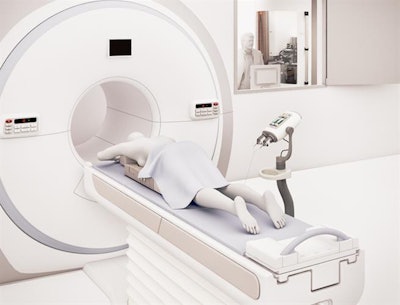 The scanner room showing a patient positioned in the MR scanner and the SPINlab hyperpolarizer in the room next door.
The scanner room showing a patient positioned in the MR scanner and the SPINlab hyperpolarizer in the room next door.The rate of pyruvate metabolism -- and the amount of lactate produced -- varies not only between different tumors but also between different regions of the same tumor. By monitoring this conversion in real-time, the researchers said they are able to determine the type of cancer being imaged. They can also determine how aggressive a tumor is, as faster-growing tumors convert pyruvate more rapidly than less-aggressive ones.
Monitoring chemotherapy
The technique will be useful for monitoring patients undergoing chemotherapy, Woitek said. It will allow determination of how efficient a given treatment is by imaging a tumor before and after the therapy, and repeatedly during the course of treatment. "Identifying patients that do not respond to a treatment will thus allow us to change the therapeutic strategy early on," she explained. "Conversely, we may even be able to reduce a treatment dose if a patient is responding well, thus sparing them unnecessary side effects."
"Researchers are beginning to understand that the many different types of breast cancer respond differently to different treatments," Woitek told Physics World. "The new hyperpolarized carbon-13 MRI approach could allow us to identify the optimal treatment for each individual patient."
The researchers have tested their technique on seven patients, all with different types and grades of cancer. They said they now hope to study larger groups of patients.
Belle Dumé is a contributing editor to Physics World.
© IOP Publishing Limited. Republished with permission from Physics World, a website that helps scientists working in academic and industrial research stay up to date with the latest breakthroughs in physics and interdisciplinary science.





